
Once again the Philippines is proud that the world notices another nature's gift with a combination of man's hard work, being one of the finalists for the New Seven Wonders of Nature. Puerto Princesa's Subterranean River National Park is now well-renowned because of its magnificent features. It is also known as St. Paul's Subterranean River National Park or St. Paul Underground River. It is located about 50 kilometers north of the city of Puerto Princesa. The National Park is situated in the Saint Paul Mountain Range on the northern coast of the island. The City Government of Puerto Princesa has been managing the park since 1992.
What is interesting with this national park is that it has a limestone karst mountain landscape with an 8.2 kilometer navigable underground river. The river becomes extraordinary because it winds through a cave before flowing directly into the South China Sea. You can see major formations of stalactites and stalagmites and has various huge chambers. Before, this river was known to be the world's longest underground river until an underground river in Yucatan Peninsula, Mexico was discovered.
It has a series of forest formations representing 8 of the 13 forest types in tropical Asia. These forests are forest over ultramafic soils, forests over limestone soils, montane forest, freshwater swamp forest, lowland evergreen tropical rainforest, riverine forest, beach forest and mangrove forest. This is also said to represent a habitat for biodiversity conservation. Researchers have discovered more than 800 plant species from 300 genera and 100 families. There are 295 trees topped by dipterocarp species.
There are also 165 bird species that can be found in the park and there are also 30 mammal species and 19 species of reptiles recorded. Examples of mammals that can be found in the park are the Palawan stink badger, Palawan porcupine, bearcat and bearded pig. The bird species found in the park are Tabon scrub fowl, Blue-naped parrot, Hill myna, Palawan hornbill and white breasted sea eagle. The park contains a full mountain-to-the-sea ecosystem. It is recognized by the UNESCO on December 4, 1999 as a World Heritage Site.

